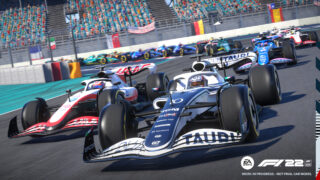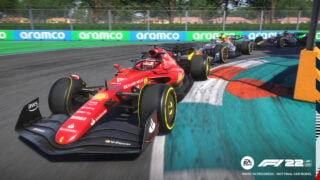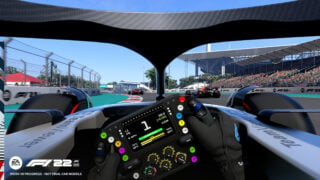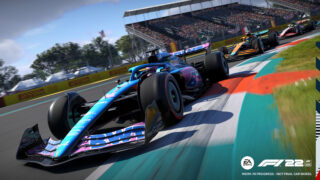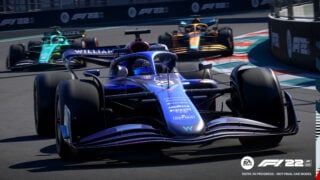‘F1 22’s VR mode made me feel sicker than Lewis Hamilton at the Abu Dhabi GP’
But with improved handling and new scalability, EA and Codemasters could be onto another winner
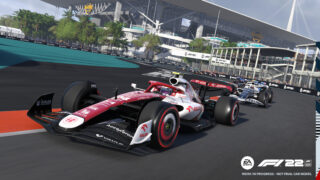
There can be no question that, on a global scale, Formula One is more popular than it ever has been.
Its growth has been remarkably rapid In North America, where what was once an extreme niche is now a big deal thanks to a combination of the Netflix documentary Drive to Survive, the hugely exciting end to the last F1 season, and the FIA’s decision to hold two US races in the 2022 season.
There’s no better time to release a new F1 game, then, given that there’s a whole new audience that wouldn’t previously have batted an eyelid at the series. This gives Codemasters and EA an interesting dilemma – how do you continue to satisfy the existing hardcore F1 fanbase, while also ensuring the game is welcoming and approachable for newcomers to the sport?
We’ve been hands-on with F1 22 (not F1 2022, the naming structure has changed) and it seems the answer is to create a game that can be as in-depth or as streamlined as the player desires, thanks to a new range of features designed to enhance the game’s realism without alienating those unfamiliar with some of the more technical elements of the sport.
A good example of this is the formation lap at the start of each race, where each driver performs a slow lap to heat their tyres and brakes, before taking their place on the starting grid. F1 die-hards can drive these, and now also have full control of their car’s positioning on the grid formation.
This means it’s now possible for players to position their car in a more offensive or defensive position on their grid slot, as so often happens in the real sport.
If the concept of the formation lap is completely meaningless to the player, however, they can instead choose to simply view an abridged version in a broadcast-style fashion, essentially boiling it down to a cutscene that adds to the TV-like presentation of the race.
The same goes for pit stops, which have been made both more and less involved too. Not only has the crew’s motion capture been given a refresh (given the new regulation wheel sizes), players now have to be wary of how they approach them.
Now the timing of the player’s turn into the pitstop can also affect the speed of their crew and potentially lead to mistakes – a wheel or wing could get stuck as a result, for example. Again, though, if the idea of trying to pull off a pitstop in mere seconds is enough to make you feel physically ill with stress, there are TV broadcast-style pit stops instead that players can just sit back and watch.
And, of course, there’s the infamous safety car, which has found itself even more in the spotlight after the obscenely dramatic end to last season. As with the formation lap and pit stops, players can choose how interactive they want safety car situations to be. If they want to physically drive behind the safety car when it comes out for that true feeling of authenticity, they can of course do this.
If, however, they hate the idea of slowly plodding along behind the thing when they just want to get on with the action, then – you guessed it – they can watch a shortened cutscene version that looks like a TV broadcast.
“We were able to go hands-on with an early version of the game, and from the brief time we’ve spent with it we can already feel a difference compared to F1 2021”
Naturally, all the other usual assists you would expect from a Codemasters racing game are in there too as standard, from braking and steering assists to anti-lock brakes, traction control and automatic ERS and DRS control. And if you don’t know what any of that means, that’s the point – you don’t have to.
Newcomer accessibility aside, F1 22 includes a number of other new features, most of which are designed to coincide with the changes made for the ongoing real-life 2022 F1 season.
Most notable of these changes are sprint races, the shorter 30-minute races that were trialled in the 2021 season and are now a proper part of the F1 calendar. These take place the day before the main race and not only establish the grid positioning for that race, but also award points to racers who finish in the top eight spots.
In Career mode sprint races will only appear when they should – only the Emilia Romagna, Austria, and São Paulo GPs have sprints in the 2022 season, so that’s the only time they’ll appear in that mode. However, if you play the Grand Prix mode, where you can choose your own custom playlist of GPs to race, you can decide whether to turn on sprint races for each circuit.

F1 22 also has a new mode, the previously leaked F1 Life (which we didn’t have access to). It’s essentially a sort of online hub area where you can customise your own home furnishings and character avatar, so online friends can then visit to see what you’ve done with the place.
There’s going to be a ‘brand shop’ and an in-game store, so it seems that this is where EA wants to bring in the microtransaction cash. We’d be stunned if limited-time items weren’t the order of the day here.
While it feels a bit superfluous, then, F1 Life does at least have one interesting feature – the ability to own and drive supercars. This is inspired by the Pirelli Hot Lap events in the real-life F1 weekend where an F1 driver will jump into one of their team’s supercars, usually accompanied by a terrified celebrity.
In the game, players will be able to collect their own supercars and drive them in various time trials and challenges. The biggest change in F1 this year, though, is what you can’t see – or rather, what you shouldn’t be able to see unless something goes horribly wrong.
New regulations mean the underside of the cars now look completely different. Instead of having ‘flat floors’, the cars now have ‘aero tunnels’, which creates what’s known as ground effects. What this means in practice is that as air flows under the car it’s pulled down more.
We were able to go hands-on with an early version of the game, and from the brief time we’ve spent with it we can already feel a difference compared to F1 2021. The ground effects give more grip on corners and lead to minimal drag on straights. Combine that with the fact that wheels and tyres are now bigger and the car feels heavier to control than it did before, yet turning feels more satisfying as a result.
The PC version will also be the first game in the series to boast VR support, but it’s still not in perfect condition at this stage. We braved it for you, dear reader, and the combination of extremely high speeds and juddery performance (it’s still two months away, after all) made us feel sicker than Lewis Hamilton did after the last Abu Dhabi GP.
That aside, though, it’s a case of ‘so far so good’ for F1 22. The handling feels improved, the addition of sprint races is a welcome one, and there’s a good level of scalability allowing players to place the game anywhere they like on the scale between ‘serious simulation’ and ‘arcade racer’.
It remains to be seen whether F1 Life truly has much to offer beyond its supercars, but regardless it looks like EA and Codemasters could be onto another winner.




